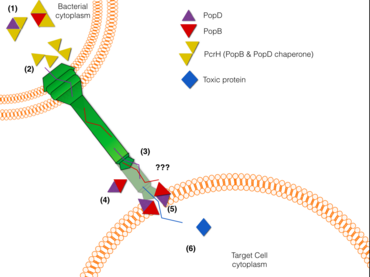Molecular Playground/Pcr H
From Proteopedia
One of the CBI Molecules being studied in the University of Massachusetts Amherst Chemistry-Biology Interface Program at UMass Amherst and on display at the Molecular Playground
PcrHIntroductionPseudomonas aeruginosa is a bacterium widely found in the environment, nonetheless is capable of infecting patients with a weak immune system. P. aeruginosa has been linked to more than 65% of cases of human infections that exhibit great resistance to antibiotics; moreover, is the predominant cause of mortality in cystic fibrosis patients. As many Gram-negative pathogens, P. aeruginosa is armed with a sophisticated Type III Secretion System (T3SS) used to inject toxic proteins into human host cells. T3SS has been shown to have an important role in disease and pathogenicity of this bacterium. The T3SS is structured like a syringe that protrudes from the bacterial membrane towards the target cell membrane. Within this system, two secreted proteins called PopB and PopD are found to insert into the target cell membrane and form a proteinaceous structure called the translocon that will connect with the syringe to serve as a gateway for the toxic proteins into the target cell cytoplasm.[1] Substantial genetic and biochemical data indicate the translocon is composed by two T3S proteins, in the case of Pseudomonas aeruginosa, the translocators protein are PopB and PopD[1]. While they are in the bacterial cytoplasm they need to be maintained in a state competent for secretion and also not toxic for the bacterial cell, the system achieves this by employing a Type II chaperone called PcrH. PrcH is a small (18.4 kDa) non-secreted bacterial co-chaperone that binds uniquely to these translocator proteins.
PcrH StructurePcrH's characteristic fold is composed of Tetratricopeptide Repeats (TPR repeats). TPR repeats consist of a 34 amino-acid sequence motif that folds into two antiparallel alpha-helices that serve as interaction modules and multi-protein complex mediators.[2] In this case, PcrH from Pseudomonas aeruginosa consist of three Tpr-like motifs. The first Tpr motif is represented in red, the second in green and the third in cyan color, also an additional alpha-helix is represented in blue. This fold is also present in Eukaryotic co-chaperons such as HOP(Heat shock protein Organizing Protein). PcrH dimerization has been reported to be required for stability of PcrH in the absence of the cargo but not their function. But their dimerization interface is controversial. In the solved structure of PcrH, it showed a dimer with back-to-back PcrH monomer (each monomer is labeled in green and blue) [3]. The interaction only seems to happen at Y95, L98 and M99 (labeled in yellow) between helix 4 in the neighboring monomers. However, Tomalka et al [2]showed by mutagenesis that the dimer should be head-to-head where monomers interact via two N terminal helices (TPR1). This result resembles the solved structure of SycD dimer [4]which is the chaperone of translocators in Yersinia and shares 59.3% identity with PcrH. (each monomer is labeled in green and blue, mutation in residue A61 and L65 labeled in yellow has been shown to disrupt dimerization)
PcrH bound to PopB/DPcrH crystal structure has also been solved when bound to a synthetic peptide carrying a homologous sequence that is present in these two translocators.[5] [3] PcrH has a charged concave cleft (Histidine and Arginine residues shown in yellow) where it binds to a sequence motif (VXLXXP) present in both PopB and PopD (9 residue peptide (rainbow) shown bound to Chain A). The VXLXXP sequence motif binding is displayed as three hydrophobic pockets in the concave side of the TPR domain receive three hydrophobic residues within the CBM present in the synthetic peptide. This interaction keeps them in a metastable non oligomeric state in the cytosol, thus protecting them from degradation and aggregation. It is also believed that PcrH has an active role in delivering PopB and PopD to the basal body of the T3S system, where an ATPse unfolds and secretes the translocators PopB and PopD. Given its key role in molecular pathogenesis PcrH is a potential target for drug design.
|
| |||||||||||
References
- ↑ 1.0 1.1 Romano FB, Rossi KC, Savva CG, Holzenburg A, Clerico EM, Heuck AP. Efficient isolation of Pseudomonas aeruginosa type III secretion translocators and assembly of heteromeric transmembrane pores in model membranes. Biochemistry. 2011 Aug 23;50(33):7117-31. doi: 10.1021/bi200905x. Epub 2011 Jul, 26. PMID:21770428 doi:http://dx.doi.org/10.1021/bi200905x
- ↑ 2.0 2.1 Tomalka AG, Zmina SE, Stopford CM, Rietsch A. Dimerization of the Pseudomonas aeruginosa translocator chaperone PcrH is required for stability, not function. J Bacteriol. 2013 Nov;195(21):4836-43. doi: 10.1128/JB.00335-13. Epub 2013 Aug, 23. PMID:23974025 doi:http://dx.doi.org/10.1128/JB.00335-13
- ↑ 3.0 3.1 Job V, Mattei PJ, Lemaire D, Attree I, Dessen A. Structural basis of chaperone recognition of type III secretion system minor translocator proteins. J Biol Chem. 2010 Jul 23;285(30):23224-32. Epub 2010 Apr 12. PMID:20385547 doi:10.1074/jbc.M110.111278
- ↑ Buttner CR, Sorg I, Cornelis GR, Heinz DW, Niemann HH. Structure of the Yersinia enterocolitica type III secretion translocator chaperone SycD. J Mol Biol. 2008 Jan 25;375(4):997-1012. Epub 2007 Nov 12. PMID:18054956 doi:http://dx.doi.org/10.1016/j.jmb.2007.11.009
- ↑ Discola KF, Forster A, Boulay F, Simorre JP, Attree I, Dessen A, Job V. Membrane and chaperone recognition by the major translocator protein PopB of the type III secretion system of Pseudomonas aeruginosa. J Biol Chem. 2013 Dec 10. PMID:24297169 doi:http://dx.doi.org/10.1074/jbc.M113.517920
Proteopedia Page Contributors and Editors (what is this?)
Carolina Morell-Perez, Yuzhou Tang, Michal Harel, Fabian Romano, Alexander Berchansky, Luis E Ramirez-Tapia


